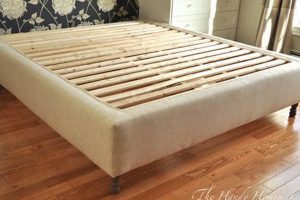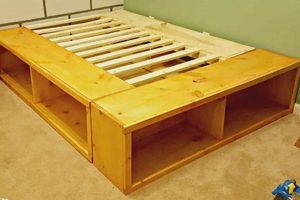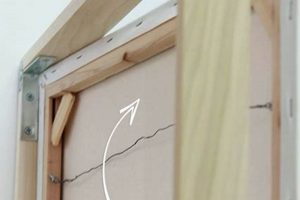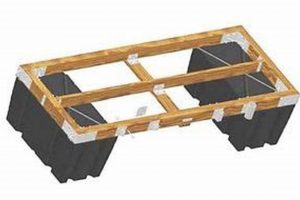Constructing a three-dimensional display case, often used for showcasing memorabilia or creating artistic compositions, can be achieved by joining two picture frames. This method offers a cost-effective and customizable alternative to purchasing pre-made display boxes. The resulting enclosure provides depth, allowing for the arrangement of objects with varying heights and dimensions. An example of its application includes preserving a collection of antique buttons, arranging pressed flowers, or displaying a cherished sports medal.
Employing this technique provides several advantages. It allows for tailored dimensions to suit specific display requirements, offering greater flexibility than standard commercially available options. The utilization of readily accessible picture frames translates to potential cost savings and promotes resourcefulness. Historically, similar approaches have been used in amateur crafting and creative repurposing projects, reflecting a tradition of ingenuity and resource optimization in artistic endeavors.
The subsequent sections detail the materials and procedural steps involved in creating such a display enclosure. The focus will be on achieving a secure and aesthetically pleasing final product, while also highlighting potential variations and customization options.
Tips for Frame-Based Display Case Construction
The successful creation of a three-dimensional display case using two picture frames requires careful planning and execution. The following tips aim to guide the process, ensuring a robust and visually appealing outcome.
Tip 1: Frame Selection is Critical: Prioritize frames of identical size and material. Discrepancies in dimensions or composition can compromise the structural integrity and aesthetic harmony of the final assembly. For instance, pairing a lightweight wooden frame with a heavier metal frame is not advisable.
Tip 2: Precise Measurement is Paramount: Accurate measurements of the inner and outer dimensions of both frames are necessary. These measurements inform the dimensions of the spacer material, which dictates the depth of the enclosure. Inaccurate measurements can lead to gaps or misalignment.
Tip 3: Spacer Material Selection Matters: Choose a spacer material compatible with the frame material. Wood, foam board, or plastic can be utilized, ensuring it is sturdy enough to support the weight of the contents and prevent warping over time. Thicker or heavier contents may necessitate a more robust spacer material.
Tip 4: Secure Adhesion is Essential: Employ a high-strength adhesive specifically designed for the materials being joined. Ensure adequate clamping pressure during the curing process to achieve a strong, lasting bond. Insufficient adhesion can result in separation or structural failure under stress.
Tip 5: Consider Glass Security: Take precautions to secure the glass or acrylic panels within the frames. Use glazier points or silicone sealant to prevent shifting or rattling. Loose panels can detract from the presentation and pose a safety hazard.
Tip 6: Finishing Touches Enhance Aesthetics: Pay attention to finishing details, such as sanding rough edges or applying paint or stain to the spacer material. A consistent finish will create a more polished and professional appearance. Consider the overall aesthetic goals of the display.
Tip 7: Content Mounting Considerations: Plan for secure mounting of the items to be displayed. Use appropriate adhesives, wires, or standoffs, ensuring that the items are stable and visually appealing within the enclosure. The method of mounting should not damage or obscure the displayed items.
Implementing these tips will contribute to the construction of a durable and visually appealing display case using two picture frames. The key is meticulous planning, accurate execution, and careful material selection.
The subsequent sections will explore advanced techniques and troubleshooting strategies for complex projects involving frame-based enclosures.
1. Frame selection
The selection of frames is paramount to the success of constructing a three-dimensional display enclosure. Frame characteristics, including material, size, and style, directly dictate the aesthetic and structural possibilities, thereby functioning as a foundational element of such a project. For instance, using frames of disparate depths necessitates complex modifications to achieve a flush and visually appealing final product. Conversely, selecting frames of identical dimensions and complementary styles streamlines the assembly process and enhances the overall aesthetic coherence.
Different frame materials, such as wood, metal, or plastic, exhibit varying strengths and adhesive properties, directly influencing the choice of bonding agents and spacer materials. A lightweight plastic frame, for example, may not provide sufficient support for heavier objects, necessitating a different approach to reinforcement than would be required for a robust hardwood frame. Similarly, the style of the frame dictates the visual theme of the display. A modern, minimalist frame will complement contemporary art, while a more ornate, antique-style frame will better suit vintage artifacts. The choice of frames therefore shapes the overall presentation and contextualization of the displayed items.
In summary, frame selection is not merely a preliminary step but rather a critical design decision that profoundly impacts the feasibility, structural integrity, and aesthetic outcome of the display case. Careful consideration of frame material, size, and style is therefore essential to ensure a successful project and effectively showcase the intended contents.
2. Spacer Material
In the construction of a three-dimensional display enclosure from two picture frames, the spacer material functions as a critical component that determines the depth of the resulting box. Its primary purpose is to create a void between the two frames, allowing for the accommodation of three-dimensional objects within the enclosure. The selection of spacer material directly influences the structural integrity, aesthetic quality, and protective capabilities of the finished display. Inadequate spacer material, such as a material with insufficient thickness or structural weakness, can lead to the collapse of the box or damage to the contents. A practical example involves the display of delicate porcelain figures. If the spacer material is too thin, the figures may press against the glass, risking breakage. Conversely, a spacer of appropriate thickness ensures adequate clearance and protection. The choice of material also affects the overall visual presentation. A spacer constructed from unfinished wood might detract from the aesthetic appeal of a professionally framed artwork, highlighting the need for careful selection of materials.
The practical application of spacer material extends beyond simply creating depth. It also plays a role in preventing moisture buildup and insect infestation within the display case. Certain materials, such as acid-free foam board, can provide a barrier against environmental damage, preserving the condition of the displayed items over time. Furthermore, the spacer can be customized to incorporate lighting or internal mounting mechanisms, enhancing the presentation and security of the enclosed objects. For example, a spacer with embedded LED lighting can illuminate a collection of mineral specimens, enhancing their visual impact. The implementation of internal mounting structures within the spacer ensures stability and prevents shifting during transport or display.
In conclusion, the spacer material constitutes an indispensable element in the construction of a three-dimensional display from picture frames. Its selection should be informed by considerations of structural stability, aesthetic compatibility, and protective capabilities. Addressing these factors ensures the creation of a durable, visually appealing, and functionally effective display solution. Challenges associated with spacer selection include material availability, cost constraints, and the complexity of integrating advanced features such as lighting or specialized mounting systems. Nevertheless, a thorough understanding of the role of the spacer material is fundamental to achieving a successful project outcome.
3. Adhesive Strength
The structural integrity of a three-dimensional display enclosure constructed from two picture frames is directly contingent upon the adhesive strength of the bonding agent used to join the frames and spacer material. This factor determines the enclosure’s ability to withstand gravitational forces, environmental stress, and potential impacts, safeguarding the enclosed items. Insufficient adhesive strength results in compromised structural stability, leading to potential separation of the frame components and subsequent damage to or loss of the displayed objects. For example, consider a display containing heavy artifacts. If the adhesive bond is weak, the weight of the contents can cause the frame to separate, leading to catastrophic failure. This underscores the criticality of selecting an adhesive appropriate for the weight and dimensions of the display contents and the materials of the frames themselves.
The type of adhesive employed must be compatible with the materials being bonded, and its application must adhere to the manufacturer’s specifications. Different adhesives possess varying levels of shear strength, tensile strength, and resistance to environmental factors such as temperature fluctuations and humidity. The selection process should consider the specific requirements of the display environment. For instance, a display located in a high-humidity area necessitates an adhesive with superior moisture resistance. Moreover, the application technique significantly influences adhesive performance. Proper surface preparation, uniform application, and adequate clamping during the curing process are essential to achieving optimal bond strength. A poorly applied adhesive, even one with high inherent strength, can result in a weak and unreliable joint.
In summary, adhesive strength serves as a fundamental determinant of the overall durability and reliability of a frame-based display enclosure. Choosing a suitable adhesive, applying it correctly, and accounting for environmental factors are crucial steps in ensuring the long-term preservation of displayed items and the structural integrity of the enclosure itself. Overlooking the importance of adhesive strength can lead to costly damages and irreversible loss.
4. Dimensional Accuracy
Dimensional accuracy, in the context of constructing a display enclosure using two picture frames, refers to the precision with which the dimensions of the frames and the intervening spacer material are measured and cut. This precision directly impacts the structural integrity, aesthetic appeal, and overall functionality of the resulting three-dimensional box. Inaccurate dimensions can lead to a misaligned, unstable, or visually unappealing final product.
- Frame Alignment and Stability
Accurate measurement ensures that the two frames align correctly when joined. Even slight discrepancies in frame dimensions can result in visible gaps or an uneven surface, compromising the structural stability of the enclosure and potentially allowing dust or moisture to enter. For example, if one frame is even a millimeter shorter than the other, the completed enclosure will exhibit a noticeable tilt or offset.
- Spacer Fit and Function
The spacer material, which provides the depth of the display, requires precise dimensions to fit snugly between the frames. Inaccurate spacer measurements can result in a loose fit, reducing the structural integrity of the enclosure, or a tight fit, causing undue stress on the frame joints. A spacer that is too short will not provide adequate support, while one that is too long may cause the frame corners to separate.
- Glass or Backing Board Integration
The glass or backing board that secures the contents within the display requires accurate dimensions to fit properly within the frame. Undersized glass can shift or rattle, while oversized glass may not fit at all, necessitating further cutting or modifications. Inaccurate dimensions can also compromise the seal of the enclosure, allowing dust or pests to enter.
- Overall Aesthetic Quality
Dimensional accuracy directly contributes to the overall aesthetic quality of the display enclosure. Precise measurements and cuts result in clean lines, flush surfaces, and a visually balanced appearance. In contrast, inaccurate dimensions can create a sloppy or unprofessional look, detracting from the presentation of the displayed items. Attention to detail in measuring and cutting is therefore crucial for achieving a polished and aesthetically pleasing final product.
The facets highlight that dimensional accuracy is not merely a technical requirement, but rather an essential element of design and craftsmanship. Neglecting precision in measurement and cutting can undermine the structural integrity, functionality, and visual appeal of the display enclosure, diminishing its value as a protective and presentational tool.
5. Glass Security
In the context of constructing a three-dimensional display enclosure utilizing two picture frames, glass security assumes critical importance. The primary function of the glass, beyond providing visual clarity, is to protect the enclosed artifacts from environmental contaminants, physical damage, and potential theft. Insufficiently secured glass poses a direct threat to the integrity of the display and the safety of its contents. For instance, improperly fastened glass may dislodge during handling or transportation, resulting in shattered glass, damaged artifacts, and potential injury to individuals nearby. The cause-and-effect relationship is clear: compromised glass security directly precipitates tangible risks.
Methods of ensuring glass security in frame-based display enclosures include the use of glazier points, silicone sealant, or specialized retaining clips. The choice of method depends on the frame material, glass thickness, and aesthetic considerations. Glazier points, for example, provide a traditional and unobtrusive means of securing glass within wooden frames, while silicone sealant offers a more robust and weather-resistant option, particularly suitable for environments with fluctuating humidity levels. Retaining clips provide a secure and easily removable solution, facilitating access to the display contents for maintenance or rearrangement. The practical application of these methods necessitates careful adherence to manufacturer guidelines and consideration of the specific vulnerabilities of the display environment.
Ultimately, prioritizing glass security in the construction of a frame-based display enclosure is essential for safeguarding valuable or fragile artifacts. The methods employed must be robust, reliable, and appropriate for the specific characteristics of the display. By effectively securing the glass, the risk of damage or loss is minimized, and the long-term preservation of the displayed items is ensured. The challenges inherent in glass security stem from the potential for material degradation over time and the need for ongoing maintenance to ensure continued protection. The concept of glass security is inextricably linked to the broader theme of responsible artifact preservation and the careful construction of durable and reliable display solutions.
6. Mounting Method
The mounting method employed within a display enclosure directly impacts the preservation, presentation, and accessibility of the enclosed objects. When constructing a display from two picture frames, this aspect necessitates careful consideration, as the chosen technique must be compatible with the frame material, the dimensions of the enclosure, and the nature of the items being displayed. A poorly selected or executed mounting method can lead to damage to the artifacts, an unappealing presentation, or difficulties in accessing and rearranging the display. For instance, using an inappropriate adhesive on delicate textiles can cause irreversible staining or structural weakening. Conversely, a well-chosen mounting strategy enhances the visual appeal of the display and ensures the long-term stability and integrity of the artifacts.
Practical applications of various mounting methods within frame-based display enclosures encompass a wide range of techniques. For lightweight items, such as photographs or pressed flowers, acid-free adhesive tapes or corner pockets can provide a secure and unobtrusive means of attachment. For heavier or more three-dimensional objects, such as medals or figurines, custom-fabricated supports or armatures may be required. These supports can be constructed from materials like foam board, acrylic, or wire, and should be designed to distribute the weight evenly and minimize stress on the displayed items. In some cases, it may be necessary to incorporate specialized mounting hardware, such as standoffs or hanging brackets, to achieve the desired presentation or level of security. Regardless of the chosen method, it is essential to prioritize reversibility and non-destructive techniques whenever possible, allowing for future adjustments or removal of the artifacts without causing damage.
In summary, the mounting method is an integral component of a frame-based display enclosure, directly influencing the preservation, presentation, and accessibility of the displayed items. The selection and implementation of an appropriate mounting strategy require careful consideration of the frame material, enclosure dimensions, and artifact characteristics. While challenges may arise in adapting mounting techniques to specific display requirements, a thorough understanding of available options and best practices is essential for creating a durable, visually appealing, and artifact-friendly display solution. This consideration underscores the overarching theme of responsible artifact preservation and the thoughtful design of effective display environments.
7. Finishing details
In the context of constructing a display enclosure by combining two picture frames, “finishing details” represent the culminating steps that elevate a functional object into a refined presentation. These details encompass actions taken after the primary construction, influencing both the aesthetic appeal and the longevity of the finished piece. Imperfections in the joining of frames, visible adhesive residue, or an unrefined surface treatment can detract from the perceived value of the displayed objects. Real-world examples include sanding rough edges, applying a consistent coat of paint or stain to the spacer material, and meticulously cleaning the glass surfaces. The absence of these finishing touches can result in a display that appears amateurish or incomplete, diminishing the visual impact of the enclosed items.
The application of specific finishing details can also contribute to the preservation of displayed artifacts. For example, applying a UV-resistant coating to the glass minimizes fading and discoloration of sensitive materials over time. Similarly, sealing the interior seams with archival-quality tape prevents the ingress of dust and pests, protecting the contents from environmental damage. The practical application of these techniques requires a careful assessment of the materials used in construction and the specific needs of the displayed objects. The choice of finishing materials should be compatible with the frame material and should not introduce harmful chemicals or volatile organic compounds that could accelerate the deterioration of the enclosed items.
Ultimately, the attention paid to finishing details is a determining factor in the overall success of a display enclosure project. These final steps transform a basic structure into a professional-quality presentation piece, enhancing the visual impact of the displayed objects and ensuring their long-term preservation. While the challenges may involve selecting appropriate materials and mastering specific techniques, the benefits of meticulous finishing are undeniable. They underscore the importance of craftsmanship and the commitment to creating a display that is both functional and aesthetically pleasing, aligning with the broader goal of responsible artifact presentation.
Frequently Asked Questions
The following addresses common inquiries regarding the construction and utilization of three-dimensional display enclosures created by combining two standard picture frames.
Question 1: What is the expected lifespan of a display enclosure constructed using this method?
The longevity of a frame-based display enclosure depends on the quality of materials used, the precision of construction, and the environmental conditions to which it is exposed. Under optimal circumstances, with robust adhesives and stable environmental controls, such an enclosure can provide decades of service. However, exposure to extreme temperatures, humidity, or direct sunlight can significantly reduce its lifespan.
Question 2: Are specific frame materials better suited for this type of construction?
Frames constructed from solid wood or high-density polymers are generally preferred due to their inherent strength and dimensional stability. Lightweight materials, such as thin plastic or composite frames, may lack the necessary rigidity to support heavier displayed objects or withstand environmental stresses. The selected frame material should be compatible with the chosen adhesive to ensure a secure and lasting bond.
Question 3: What adhesive types are recommended for securing the frames and spacer material?
Epoxy resins and cyanoacrylate adhesives (super glues) offer strong and durable bonds suitable for joining various materials commonly found in picture frames. The specific adhesive should be selected based on the compatibility with the frame and spacer materials and its resistance to environmental factors such as moisture and temperature fluctuations. Proper surface preparation and clamping are essential for maximizing adhesive performance.
Question 4: How can the ingress of dust and pests into the display enclosure be prevented?
Sealing all seams and joints with archival-quality tape or silicone caulk is crucial for preventing dust and pest infiltration. The selected sealant should be non-toxic and chemically inert to avoid damaging the displayed objects. Regular inspection and maintenance of the seals are recommended to ensure continued protection.
Question 5: Is it possible to incorporate lighting within a frame-based display enclosure?
The integration of lighting is feasible, but requires careful planning and execution. Low-voltage LED lighting is generally preferred due to its low heat output and energy efficiency. The wiring should be concealed within the spacer material, and appropriate ventilation should be provided to prevent heat buildup. Consultation with an electrician is recommended to ensure safe and compliant installation.
Question 6: What precautions should be taken when displaying sensitive or valuable artifacts within this type of enclosure?
The enclosure should be constructed from archival-quality materials that are chemically inert and non-reactive. UV-filtering glass or acrylic should be used to protect artifacts from light damage. A desiccant can be placed within the enclosure to control humidity levels. For extremely valuable items, consider incorporating a security system or storing the enclosure in a controlled environment.
In summary, constructing a durable and effective frame-based display enclosure requires careful attention to material selection, construction techniques, and environmental controls. Addressing these factors ensures the long-term preservation and presentation of displayed objects.
The subsequent sections will delve into advanced techniques and customization options for enhancing the functionality and aesthetic appeal of frame-based display enclosures.
Conclusion
The preceding discussion has explored the multifaceted aspects of creating a three-dimensional display enclosure by uniting two standard picture frames. Key points emphasized encompass material selection, dimensional accuracy, adhesive properties, glass security, mounting techniques, and finishing details. The interrelation of these elements dictates the durability, aesthetic quality, and protective capabilities of the final product. A failure to adequately address any of these considerations can compromise the integrity of the enclosure and the safety of the displayed items.
Given the potential benefits and inherent challenges, individuals undertaking such projects should approach the endeavor with meticulous planning and diligent execution. The successful creation of a lasting and visually appealing display rests upon a commitment to quality craftsmanship and a thorough understanding of the principles outlined herein. Future advancements in materials science and adhesive technology may further refine this technique, but the fundamental principles of sound construction and responsible artifact preservation will remain paramount.







